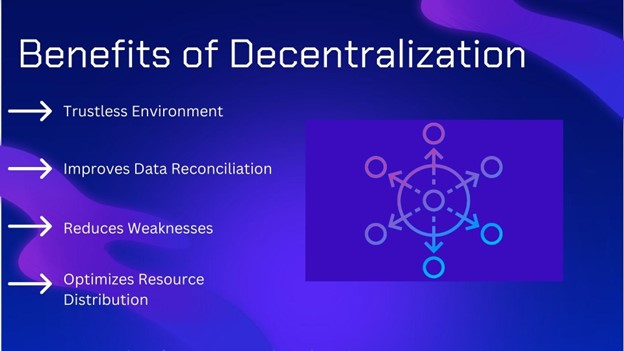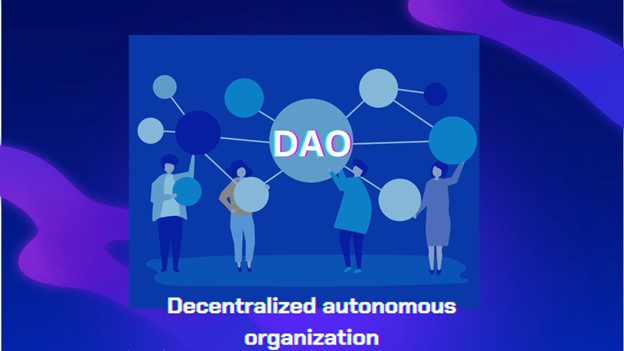In a literary context, Decentralization means the dispersion of control and decision-making across numerous individuals rather than having a single central authority in charge.
Put simply, it's akin to having a group of friends collaborating to make decisions together rather than letting a single person control the outcome. This way, power isn’t concentrated in a single entity, and everyone gets to contribute to the functioning of the group.
In the context of blockchain, decentralization means that no single entity holds dominion over the entire network. Instead, a multitude of computers, known as nodes, collaborate to maintain the system's integrity. This helps make the system more secure and trustworthy as no single entity can control or manipulate it.
Why Does Decentralization Matter?
Decentralization is a concept that has been introduced previously, especially when it comes to technological development. When creating a tech solution, there are typically three primary ways to organize the network - centralized, distributed, and decentralized.
-
Centralized: Picture a single authority making all decisions, similar to one boss overseeing everything within a centralized network.
-
Distributed: Imagine a collaborative effort among a group of friends, each contributing equally. This is a distributed network, where tasks and responsibilities are shared among multiple entities.
-
Decentralized: Imagine a large gathering of friends where no single individual holds central authority. In this scenario, everyone has a voice and operates as equals, reflecting a decentralized network where control and decision-making are dispersed among numerous participants.
Decentralization Dynamics in Blockchain
When we talk about blockchain, it often uses a decentralized network. But here's the thing - a blockchain application doesn’t adhere strictly to a binary decentralization model. Instead, decentralization operates along a spectrum, with different aspects of the application varying in their degree of decentralization.
By distributing control and access to resources in a blockchain application, one can achieve more efficient service for everyone involved.
However, Decentralization comes with its own set of tradeoffs. For example, it might result in lower transaction speeds. But in the end, the benefits of decentralization, such as heightened stability and fairness, often outweigh these drawbacks in the long run.
Benefits of Decentralization
Now, let's explore the advantages that decentralization brings to the table.

- Trustless Environment
Decentralized blockchain networks operate on the principle of mutual verification, eliminating the need for trust among people. Each member possesses an identical copy of the data, leading to transparency and accountability.
Any attempt to alter the data is promptly identified and rejected by the network. This makes the system trustworthy without relying on trust between participants.
- Improves Data Reconciliation
Usually, when companies share data, it's stored disparately in different places, which can lead to errors or data loss.
However, with a decentralized system, everyone shares the same real-time data, eliminating chances of errors or data loss.
- Reduces Weaknesses
Decentralization helps to reduce vulnerabilities that are prevalent in a centralized system, where there is too much reliance on specific people. This approach helps prevent problems like service interruptions, lack of resources, or corruption.
- Optimizes Resource Distribution
By dispersion of control and access to resources, decentralization can make services more reliable and consistent. It helps to make sure everyone gets what they need, without encountering significant obstacles.
Comparing Centralized, Distributed, and Decentralized Systems
Let's break down the comparisons between centralized, distributed, and decentralized systems in simpler terms.
- Centralized System
In a centralized system, all resources and control are held by one entity, typically in one location. Everything, from solution components to data, is under the control of this central authority.
However, this setup holds a significant risk because if something goes wrong with this central entity, the entire system can fail. Security and fault tolerance are lower in centralized systems because everything relies on this single point of control.
An example of a centralized system is an ERP (Enterprise Resource Planning) system where one company manages all aspects.
- Distributed System
Moving to a distributed system, resources are spread across multiple locations and managed by a network provider. While the solution components are managed by a single provider, the data is usually owned by the customers.
Unlike a centralized system, there's no single point of failure in a distributed setup, making it more reliable. This distribution of resources also improves security and fault tolerance since the resources are spread out.
An example of a distributed system is cloud computing, where resources are spread across different data centres.
- Decentralized System
Now, in a decentralized system, network resources are owned and shared by all network members, making it challenging to maintain because no single entity owns them. Each member of the network holds the same copy of the distributed ledger, and data is collectively owned by everyone in the network, added through group consensus.
Decentralized systems have high fault tolerance because there's no single point of failure and security increases as more members join the network.
A prime example of a decentralized system is blockchain networks like Bitcoin or Ethereum, where transactions are verified and recorded by a distributed network of nodes without a central authority.
Builders of Decentralized Blockchain Applications: Diverse Innovators in Action

Every blockchain solution, like decentralized apps (dApps) or organizations (DAOs), can have different levels of decentralization. The level of decentralization depends on things like:
-
The maturity of the solution.
-
Reliability of its incentive models and consensus mechanisms.
-
The balancing act of the founding team.
Take, for instance, a Decentralized Autonomous Organization (DAO), where different components may have varying levels of decentralization. Some parts, like oracles (services that provide external information to smart contracts), might be partly decentralized. Other parts, like smart contracts, might be fully centralized.
Additionally, decision-making processes and change mechanisms might be community-driven and decentralized.
In the bigger picture, decentralized blockchain solutions find application across diverse organizations, both large and small, spanning various industries.
For example, some apps use blockchain to provide fast aid to people in emergencies, eliminating the need for intermediary entities like banks or government agencies. On the other hand, some let people control their own digital identities and data, countering the prevalent practice of social media platforms and corporations profiting from users' data without equitable compensation.
Wrapping Up
Decentralization in blockchain technology is a powerful force reshaping how we approach authority and control. It promotes an even power distribution, allowing individuals to contribute meaningfully to decision-making.
Despite potential trade-offs like slower transaction speeds, its long-term benefits in stability and fairness make it an important aspect of modern innovation.
Ultimately, decentralization is a shift towards a more inclusive and transparent digital future, promoting empowerment and collaboration.